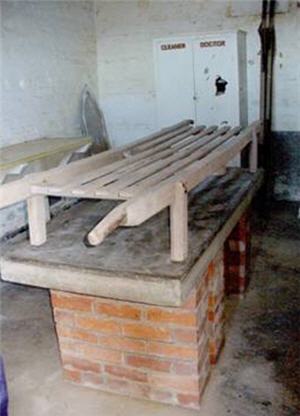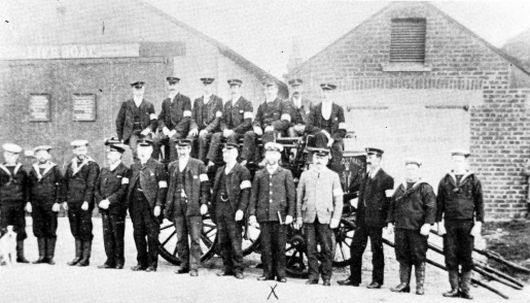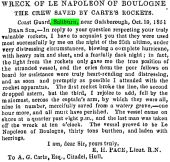Discovering Saltburn's rich heritage and varied history.
The east coast holds the record for the largest number of sea disasters round the shores of the British Isles. What the North sea lacks in size it makes up for in ferocity and when a north easterly gale is blowing there is no place on Earth more hostile to man.
A corner in Old Saltburn - The Mortuary
Until 1881, the Ship Inn had the dubious distinction of also being used as the local mortuary for victims of drowning. Regular occurrences of bodies being washed up on the beach - which had to be accommodated at the Ship Inn whilst awaiting post mortem - prompted the need for a mortuary. This was eventually built for Brotton Local Board, the key being available at Mr Temple's house! The Saltburn Local Board had apparently declined to contribute to the cost of building the mortuary.
The Mortuary was one of three buildings on the site, the nearest to the Ship Inn being the Lifeboat House and sandwiched between that and the Mortuary was the Rocket Brigade building.
Today only the Mortuary remains standing as the Lifeboat House and the Rocket Brigade house were demolished in a road widening scheme.

The Mortuary was known to have been in use at least until the late 1960's but a chance conversation between Tony Lynn and Doug Kitchen, retired local undertaker, revealed the following information:
It would seem that the general impression about the Mortuary is that it was only used for bodies washed up on the beach and rocks. This was not so. Until the early 1970's when Cleveland County was formed, all persons who died as a result of "sudden death" were taken to the Mortuary on the authority of the Cleveland Coroner who had an office in Guisborough.
"Sudden death" was in fact apart from accidental death, when a doctor could not state the cause of death or the person had not seen a doctor in the last fourteen days.
The body was then removed by the Coroner's Officer, who was the local policeman on duty and the undertaker. The Coroner would then decide whether a post mortem was necessary or if the body could be returned to relatives for burial or cremation.
On this basis the Mortuary was used regularly on what we would today term 365/24.
Many was the time when undertakers would be got out of a nice warm bed in the middle of a winter's night to do a removal, when the wind was gale force off the sea with freezing rain, sleet or snow coming in horizontally. Having said that, on weekends, Bank Holidays etc, when the beach was packed with visitors, a police car and a van backing up at the mortuary attracted dozens of nosy parkers, mainly children, asking questions such as "Who's dead mister?" or because a policeman was present "Has someone been murdered?"
Those days came to an end when Cleveland County was formed, and full time coroner's officers were appointed within the whole of the County and bodies were removed straight to the pathology department at Middlesbrough General Hospital.
 The Mortuary is a Grade II listed building. Internally many original features are intact.
The building had been used in more recent years as a wood store and before that as a photographers studio.
Tees Valley Wildlife trust had used the building since the mid eighties until recently.
In September 2007 Tees Valley Wildlife Trust and English Heritage opened the Mortuary to the public for four days.
The tiny room, 12ft x 18ft, became a mini museum which received over 1000 visitors eager to
visit the last resting place of dozens of individuals during its working lifetime.
The future of the building is as yet uncertain but a friends group has been formed and is working
closely with the local authority to try to ensure that the Mortuary will remain standing as a sentinel
for many years to come. It has been suggested having a glass door on the front of the Mortuary with a light inside
(two small skylights provide the only lighting in the building) and appropriate signage
until such time as a scheme for the whole area is agreed upon and is able
to be carried out.
The Mortuary is a Grade II listed building. Internally many original features are intact.
The building had been used in more recent years as a wood store and before that as a photographers studio.
Tees Valley Wildlife trust had used the building since the mid eighties until recently.
In September 2007 Tees Valley Wildlife Trust and English Heritage opened the Mortuary to the public for four days.
The tiny room, 12ft x 18ft, became a mini museum which received over 1000 visitors eager to
visit the last resting place of dozens of individuals during its working lifetime.
The future of the building is as yet uncertain but a friends group has been formed and is working
closely with the local authority to try to ensure that the Mortuary will remain standing as a sentinel
for many years to come. It has been suggested having a glass door on the front of the Mortuary with a light inside
(two small skylights provide the only lighting in the building) and appropriate signage
until such time as a scheme for the whole area is agreed upon and is able
to be carried out.
The Rocket Brigade
The Volunteer Rocket Brigade originated in the early 19th Century with the introduction by Captain George Manby (1765-1854), who lived in Gorleston, of his mortar and rocket-firing rope line apparatus enabling sailors stranded on ships close to shore to be winched to safety. His first success was at Great Yarmouth, 150 yards from the shore, when Manby saved the lives of sailors from the brig Elizabeth with his mortar.
If the stranded vessel was too far from shore for the mortar or rockets, then a boat was used to row the "Rocket" men nearer to the vessel. Once the rocket was fired the rope could then be brought back to shore and tightly secured.
The Volunteer Rocket Brigade, though not part of the RNLI, worked alongside them in rescuing sailors in distress. In the case of an emergency the Volunteers were summoned by a 'maroon, an explosive device not unlike that used to launch the lifeboats.
The basic function of the Rocket Brigade was to save lives by aiming a rocket with a line attached to it at a boat or ship in trouble, the line providing a link between the vessel and the shore. However bizarre this may seem it actually worked and a number of successful rescues have been recorded. One successful rescue was the retrieval of 13 crewmen from the Samarang which had run aground on Marske beach in 1884. In this rescue operation and lifeboats and rocket brigades of both Redcar and Saltburn were involved

It has been suggested that Rocket Life Saving Apparatus was introduced to Saltburn in 1858, shortly after the First lifeboat, and Coastguard records state that a Voluntary Company was not formed until 1884. However, a letter published in the Hull Packet on Friday 24 October 1851 by Lieut.E H Pace, R.N. shows that the Coast Guard clearly had the use of Carte's rockets during the rescue of at least one vessel at that time.
In the early days practices were held at Hazelgrove, shooting from one side to the other, but during the 20th century two fields south and north-east of Upleatham church were used.

Saltburn Rocket brigade outside the Lifeboat House and Rocket Brigade house.
Research by Rebecca Hilton. Collecting primary source materials, articles and extracts from books related to the development of both Saltburns and trying to validate them has offered conflicting information, much of which is often difficult to validate as many sources can prove to be unreliable e.g. newspapers or census data. Every effort has been made to ensure that the information on the history of the town presented here is as accurate as possible.

